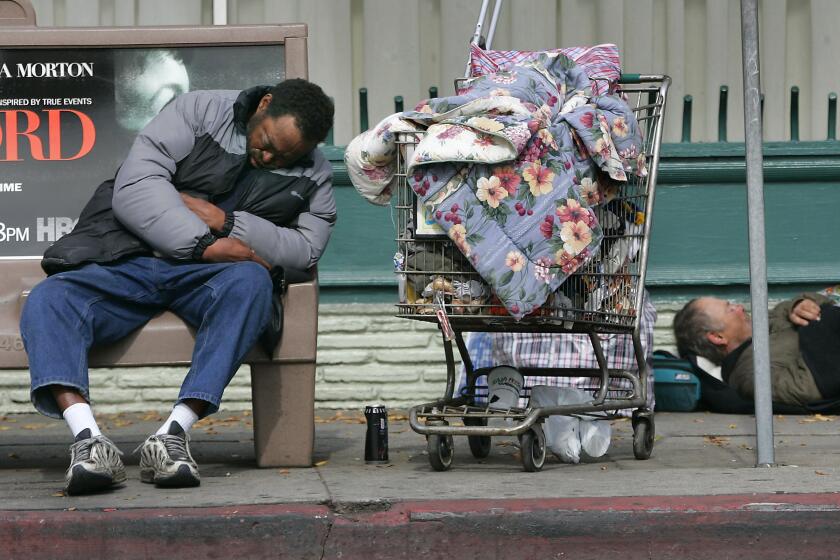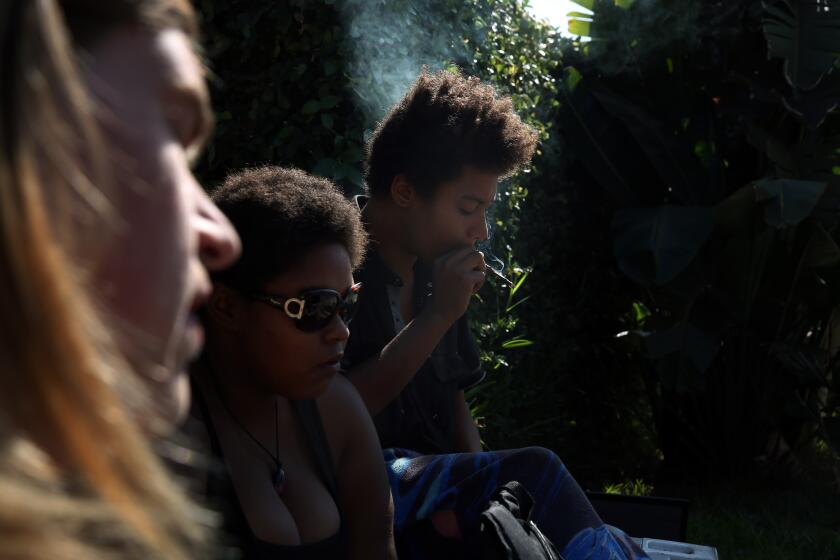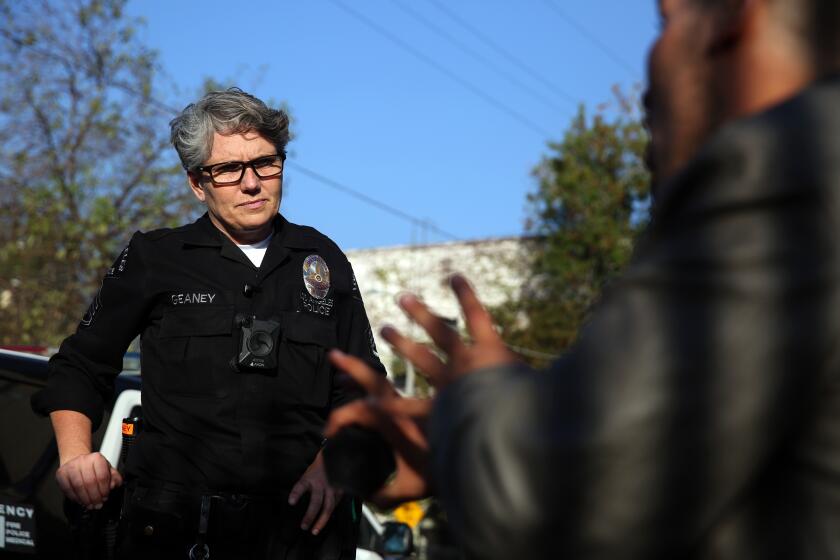Column: When an L.A. homeless camp rises outside your window: ‘You have no idea the hell I was living’
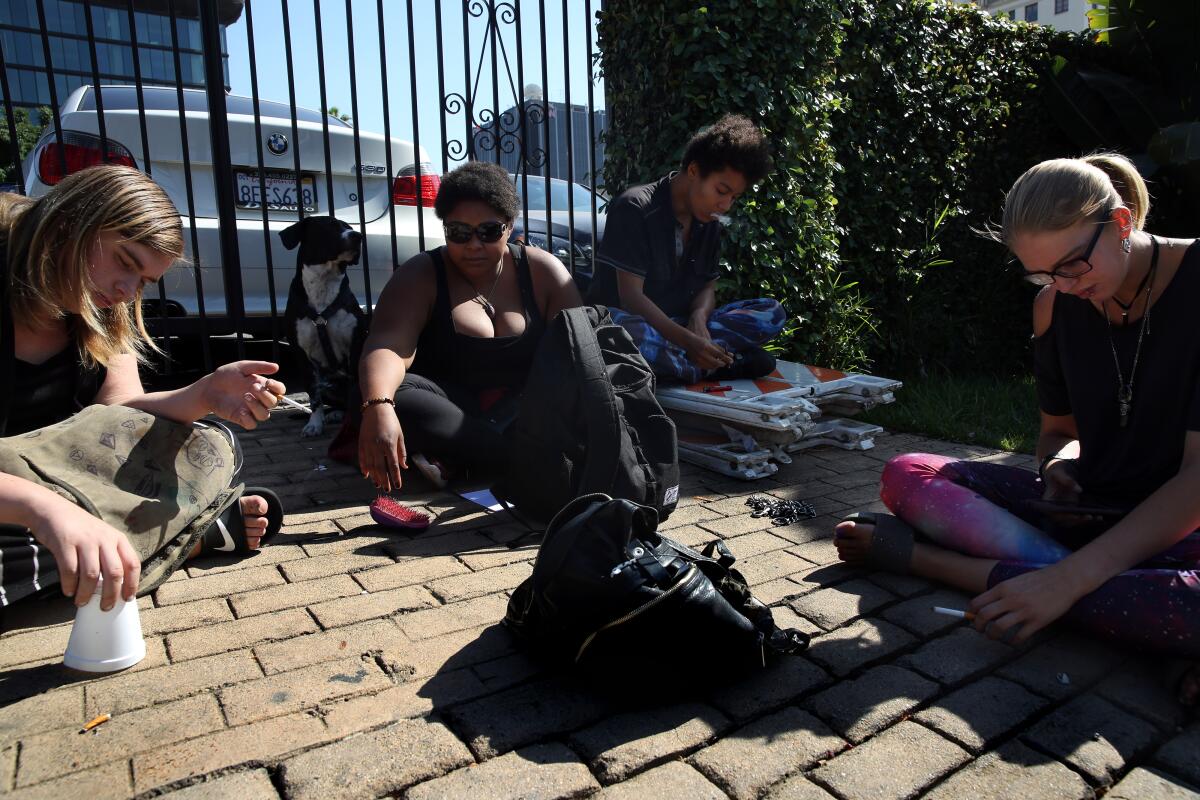
- Share via
Part One: The residents
The trash, the fights, the drugs, the blaring music.
For months, it was relentless.
“It was intolerable,” said Greg, who lives in a Hollywood neighborhood surrounded by homeless encampments, including one that until recently was just a few feet from the windows of his apartment. He wore headphones and turned up the AC to drown out the cacophony. Nothing worked.
“You have no idea the hell I was living.”
Tents and tarps have become a part of the streetscape in L.A. County, which is home to an undeclared state of emergency. We’re all witness to disturbing scenes of human suffering, unrestrained drug markets and festering illegal dump sites, although for most of us, the calamity is not at our doorstep.
But last summer, for Greg and his neighbors near Hollywood Boulevard and Gower Street, there was no escaping the impact of L.A.’s greatest unsolved challenge.
An exclusive poll done for the Los Angeles Times and Los Angeles Business Council Institute found that 95% of respondents believe homelessness is either a serious or very serious problem.
They felt, as have residents in Venice and elsewhere, as if they had lost their neighborhood and that nobody — including anyone at City Hall — cared enough to do anything about their deteriorating quality of life.
“Sometimes there was constant screaming, and the N-word, and people screaming that they were going to kill each other, and music playing nonstop,” said Marissa, who works at home and tried meditating to get through it.
“I honestly feel like I’m going insane,” she wrote in a July email to neighbors and public officials.
The apartments these people live in are middle-class dwellings, with some rents well below $2,000 a month. I spoke to a bookkeeper, a media company manager, a book editor, a pharmacy manager, all of whom asked me not to use their last names because they fear reprisals for calling out what’s happening.
One resident, Gil, got together with neighbors and spent $1,000 on planter boxes, arranging them in a way they hoped would discourage overnight camps in the cul-de-sac. It didn’t work. Some of the plants were destroyed; some of the pots became trash receptacles.
‘I used to be able to walk to work ... but I won’t do it anymore.’
— — Jeff Briggs, Hollywood resident
Gone, Gil said, are the days when he hosted family gatherings at his home.
“I don’t dare invite them back,” he said. “It’s a rough place.”
In July, when I first heard about what was happening, I visited to have a look. Since then, I’ve made frequent trips to the area, because it provides an excellent vantage point for exploring colliding perspectives on an epidemic that’s got Los Angeles in its grips.
Residents wonder if too many people — including young folks arriving daily from all over the country — view tents on the streets of Hollywood as a destination rather than a last resort.
Homeless people, some of them drained of hope and struggling to survive, say they have nowhere to go.
And an LAPD detective who walks this beat is stuck with the frustrating task of trying to keep order in a city with a raging drug epidemic, too little housing and no clear strategy to turn things around anytime soon.
You’ll be hearing from all of them.
::
Hollywood and homelessness are not strangers. I remember a night in 2017 when, while working on a column about severely mentally ill people decaying on the streets, I saw someone pop out of a manhole on Gower, near the First Presbyterian Church of Hollywood, and scamper toward a row of tents.
Nothing surprises in this part of town, where bright lights throw long shadows. What’s different now is that on top of misfortune, mental illness and poverty in the capital of high rent and low wages, drug addiction has spread unchecked through the streets, making its victims all the more difficult to reach. In Hollywood, the patience of residents has worn thin in places where camps have grown and a sense of futility has settled in.
Four months ago, I was added to an email list residents set up to air their grievances about the camps near Carlos and Tamarind avenues. It included police officers, Mayor Eric Garcetti, Councilman Mitch O’Farrell and others. Residents sent photos, recordings and first-person accounts to back up their claims that they were under siege.
“I was threatened with violence,” Greg wrote in an August email, describing an encounter with a homeless person. Twice, Greg told me, his car was keyed, possibly by someone who knew he was in touch with authorities.
To keep things in perspective, no one is more prone to physical assault than the homeless people themselves. But as a rule, Greg and others said, they avoided sharing their grievances with homeless people, fearing what might happen if someone was unhinged by drugs.
That sense of helplessness only fueled their frustration. Were they reduced to accepting this level of havoc as the new norm? Were they supposed to go to work, pay their bills and their taxes, and get so little in return even after weeks of emailing and calling local officials to plead for help?
“I’ve seen someone roll up a sleeve and just shoot up,” said Brian, a longtime resident. “I’ve seen someone [defecate] on the street. I once saw a skirmish where one guy was hitting another guy over the head with a board.”
“If the LAPD can’t help, does anyone have any ideas of what we can do as a community?” Marissa wrote to the email group. “How do we keep the peace, stop people using the sidewalks as a toilet and trash dump, and protect ourselves when the lack of support from authorities means this group is essentially now a ‘camper gang’ who controls our street, threatens residents, and openly fights and carries tasers?”
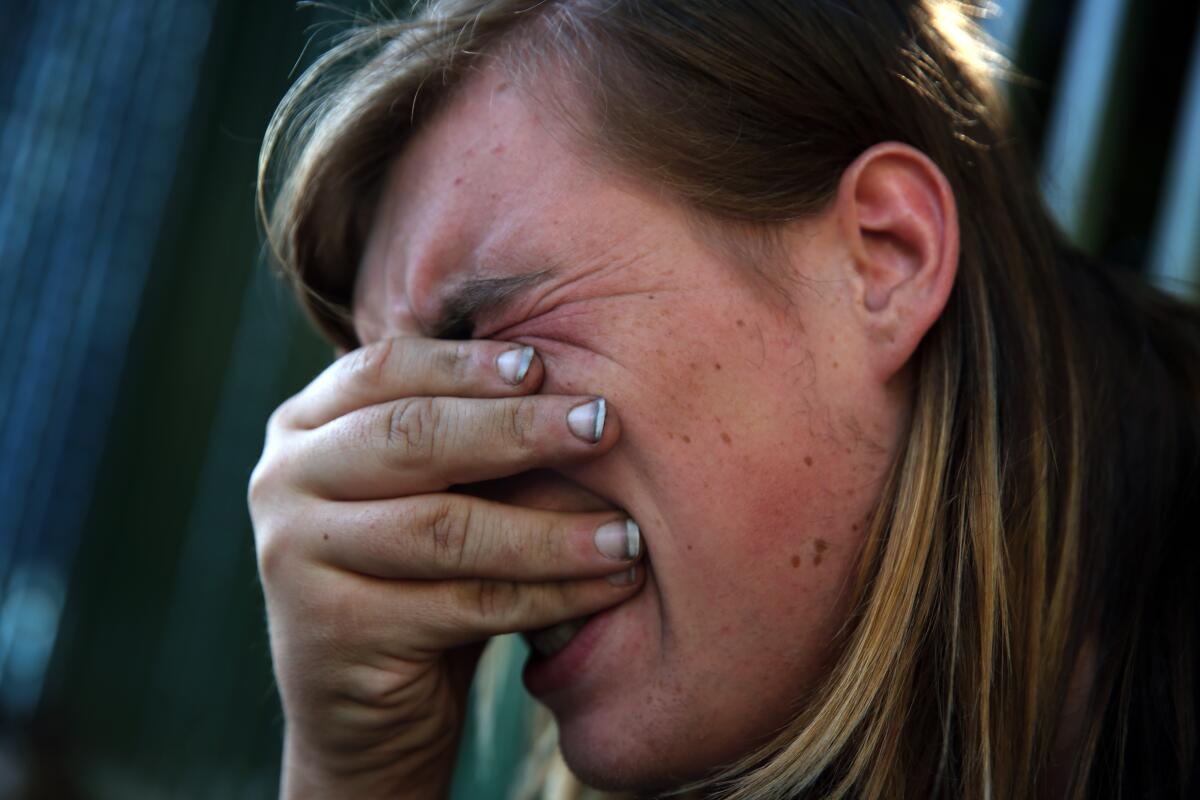
Often, street dwellers form smaller groups within the larger scene, and through the summer, a cohort of people in their 20s and 30s spent their days and nights clustered together on Carlos Avenue. A woman known to everyone as TK was in charge of the mostly LGBTQ crew.
TK’s group did not appear to mingle much with those who frequented the tents 50 feet away in the cul-de-sac on Tamarind Avenue, where vehicles sometimes pulled up to deliver what I’m pretty sure were not pizzas.
One day I was talking to a young woman who was moving into the building at the intersection and she said she had a “live and let live” attitude, so the street scene didn’t bother her. But as we spoke, a drama was unfolding just a few feet away from us.
Someone TK thought didn’t belong had wandered onto her turf, strutting and ranting, high on meth by appearances. When he tried to enter a tent, TK called out to her posse, and they chased the guy down. Someone punched him in the mouth and he staggered, but then he popped back up, ready to fight. He was ordered to leave, or else, and he slowly retreated, still screaming profanities.
The woman moving into the apartment appeared to be reassessing the situation. I asked if she thought she’d feel safe walking down Carlos Avenue at night. No, she said. Probably not.
Several weeks ago, Carlos and Tamarind avenues got quieter. TK and her crew cleared out, though residents didn’t know why or where they went. Even the cul-de-sac tent population began to thin, leaving behind broken bottles, a used condom, insect-covered food containers.
“It’s been such a relief,” Greg said, but he knew the return to sanity was likely to be short-lived. He’d seen the cycles before. One group moves out, another moves in. And there were still tents half a block away on Carlos, closer to the Presbyterian church, and growing encampments nearby — at Carlos and Bronson avenues, and at Gower under the 101 Freeway.
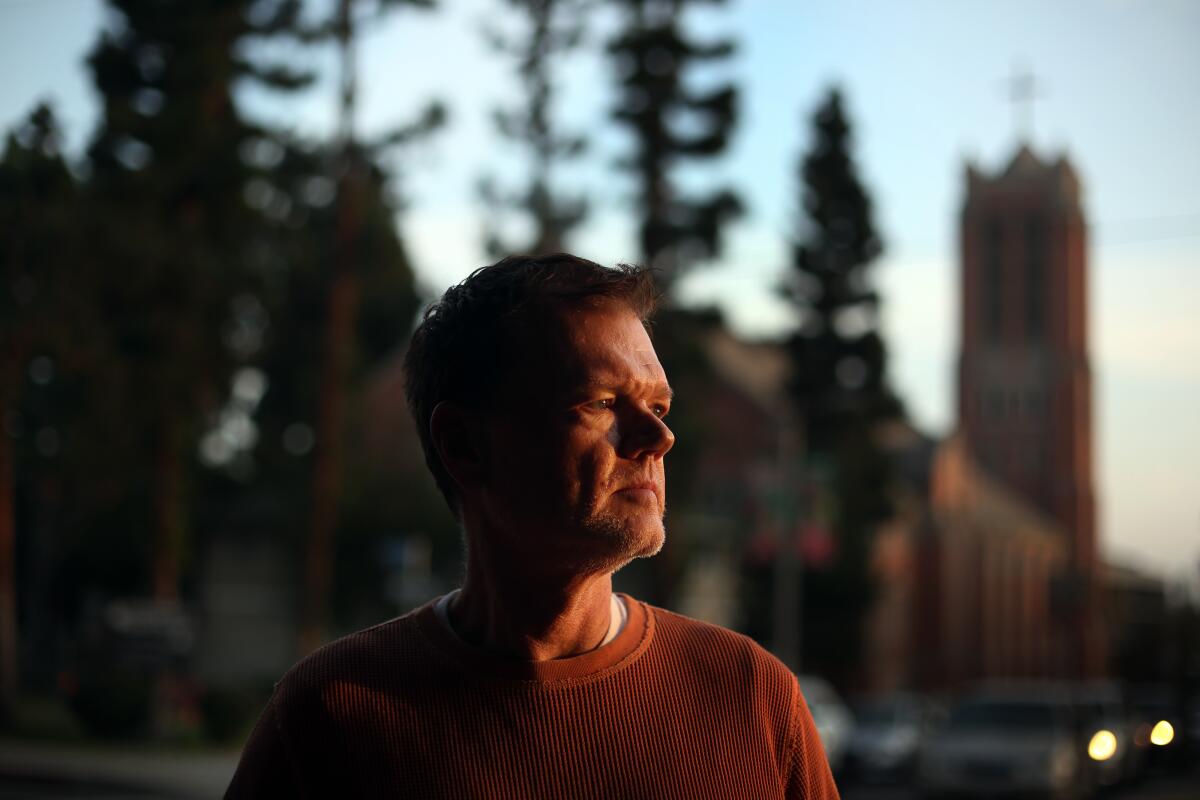
“I used to be able to walk to work … but I won’t do it anymore,” said Jeff Briggs, an attorney who lives near those encampments and says they’ve gotten worse in recent months. Briggs said he’s been verbally assaulted and his family has asked him to drive, not walk, because they fear for his safety.
Jesse Coley, who lives near Briggs, said she’s stopped walking with her young daughter to the Red Line and the Hollywood Farmers Market.
“I don’t feel good complaining about it. It’s definitely a sad situation,” Coley said. “It’s denser than it’s ever been and the tents go on for a longer stretch along the sidewalk. There are tents set up where they never were.”
What’s all the more maddening about this, Briggs said, is that the community was promised by city officials that there’d be noticeable improvement on the streets after the opening of the Schrader shelter, which provides bridge housing for people trying to get off the street, last spring.
More From This Series
Briggs was a founding member of Hollywood 4WRD, which has been working on solutions to homelessness for years, and he said he supported the shelter. But he now wonders if Schrader, a 7,200-square-foot facility that cost more than $3 million to build and will cost millions more to operate, has been anything other than “a very expensive experiment.”
Briggs wants more information on how many people have been helped, and whether the other planned bridge shelters — a key part of Garcetti’s plan to curb homelessness, with a $77-million price tag for 25 sites — will be designed and managed well enough to make a difference.
More on that later, but in a broader sense, the problems in Hollywood are illustrations of a systemic failure to harness the growing challenges of homelessness. What I found was not a lack of support from authorities but an inefficient response sabotaged by a lack of coordination and clear strategy.
There has been more outreach in Hollywood since the shelter opened, more police attention and more people connected to housing. Four of TK’s buddies are now in shelters. But there is nowhere near enough of any resource, whether it’s housing, addiction rehab or mental health treatment. And for every person rescued, another washes ashore. That may be especially true in Hollywood, which draws people both because it does have resources and because of the mythical allure of the place.
Late next year, a pilot mental health program based on an Italian model might bring some relief to Hollywood. And some of the housing approved by voters is finally going to be ready soon.
But that housing has taken way too long to build, cost way too much, and even when done, will leave us with staggering shortages, still.
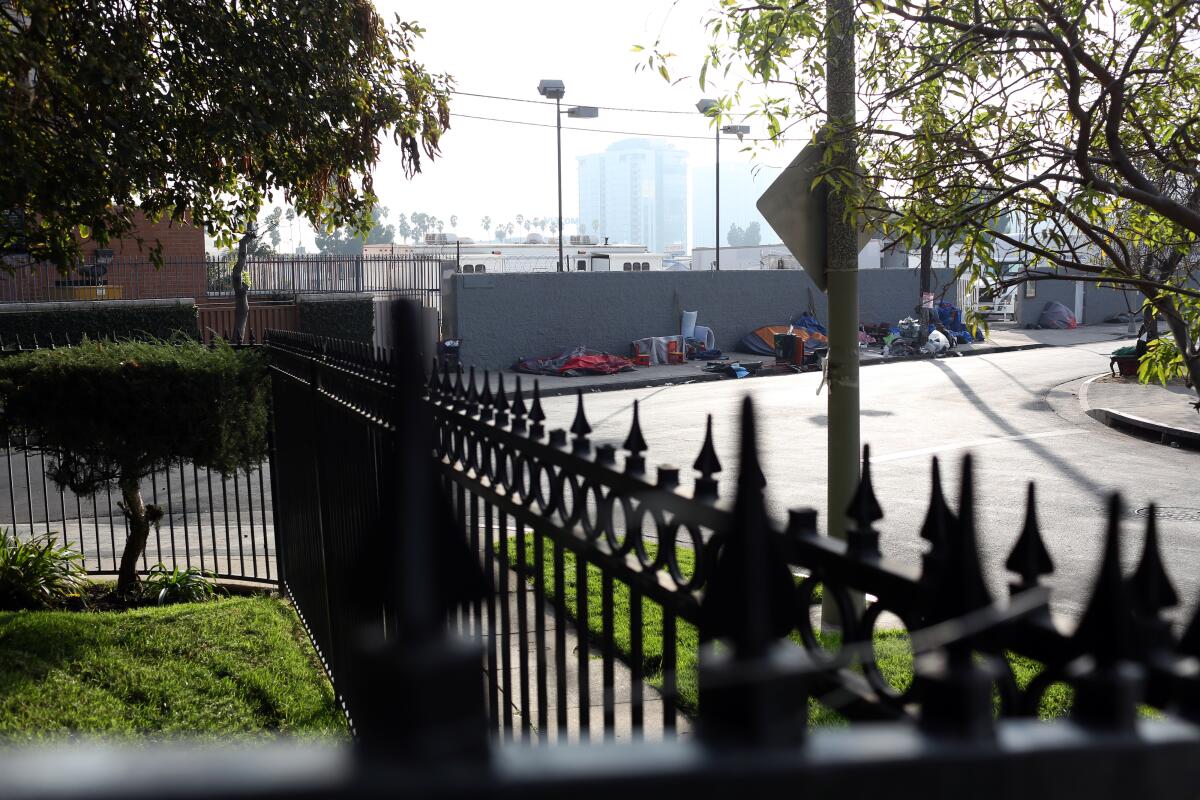
In Hollywood, I heard support for the radical and expensive idea of building enough living space for every Californian and then requiring people to come indoors. I heard talk about limiting how much time someone can stay on the same slab of pavement, and offering bus tickets to those who might have a better chance of finding help, jobs and housing in the places they came from.
“I swear I am sympathetic, and I feel bad for people, and I want them to get the help they need,” Greg said one night in his apartment building.
They came to Hollywood from Ohio, Tennessee, Idaho, Oregon, and ended up on the streets. One thing they have in common: past trauma.
But he and his neighbor Brian wondered if some of the campers have given up or chosen to drop out. Others I spoke to wondered if there are too few consequences for using drugs in public, blocking sidewalks and littering streets.
A week or so after residents told me they were relieved by an improving situation on Carlos Avenue, a stained queen-size mattress appeared on the sidewalk just down from their building. And then someone dumped a sofa.
I watched as one man pitched a tent, and when I returned the next night, there was another. Others followed, and the encampment was not just growing, but moving closer to the apartment buildings where residents had a summer they will never forget.
More to Read
Sign up for Essential California
The most important California stories and recommendations in your inbox every morning.
You may occasionally receive promotional content from the Los Angeles Times.

